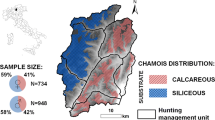Abstract
Fluctuating asymmetry (FA) in ornamental characters may reflect developmental stability in the translation from genotype to phenotype. Antlers of reindeer show FA, are visually conspicuous ornaments and are important in intraspecific assessment. We show that there is a negative relationship between size and asymmetry in visual antler characteristics (i.e., antler length and number of tines) among free-ranging male reindeer in rut. This indicates that individuals that develop large ornaments are better able to buffer developmental stress than individuals that develop small ornaments. There is no relationship between asymmetry in antler length and asymmetry in jaw length, suggesting that symmetry in antlers does not reflect overall body symmetry. This difference may be caused by trait-specific sensitivity to developmental stress. Such stress may partly be caused by parasites, which show a positive association with asymmetry in antlers, but no relationship to asymmetry in jaws. Our results indicate that antlers may be exposed to directional selection in a visual signaler-receiver system and that information about parasite burden may be obtained from evaluation of asymmetry in antlers developed under exposure to a multitude of environmental stresses.
Similar content being viewed by others
Author information
Authors and Affiliations
Additional information
Received: 8 October 1996 / Accepted: 13 January 1997
Rights and permissions
About this article
Cite this article
Markusson, E., Folstad, I. Reindeer antlers: visual indicators of individual quality?. Oecologia 110, 501–507 (1997). https://doi.org/10.1007/s004420050186
Issue Date:
DOI: https://doi.org/10.1007/s004420050186




